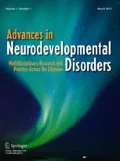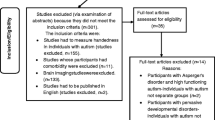Abstract
Communication is a key area for early intervention for pre-schoolers with autism spectrum disorder (ASD). Therefore, there is a need for reliable and valid communication assessment measures for this population. Two commonly used measures are the language scales of the Mullen Scales of Early Learning (MSEL) and the Preschool Language Scale—Fifth Edition (PLS—5). To date, limited research has compared these. The aim of the present study was to investigate the similarities and differences in scores on the two instruments for children with ASD and those who were developing typically. The MSEL and the PLS—5 assessments were administered to 49 pre-schoolers including 24 children with ASD and 25 typically developing (TD) children. Language scores on the MSEL and PLS—5 were highly correlated within each group. As expected, children with ASD performed significantly lower on both language measures compared to children who were developing typically. Children from both groups performed higher on the PLS—5 than the MSEL on the expressive language scale, and typically developing children also performed higher on the receptive language scale. Limitations and future directions for research in terms of test selection are discussed.
Similar content being viewed by others
References
Akshoomoff, N. (2006). Use of the Mullen scales of early learning for the assessment of young children with autism spectrum disorders. Child Neuropsychology: A Journal on Normal and Abnormal Development in Childhood and Adolescence, 12, 269–277. https://doi.org/10.1080/09297040500473714.
American Psychiatric Association (2000). Diagnostic and statistical manual of mental disorder (4th ed., text rev.). Washington, DC: Author.
Berument, S., Rutter, M., Lord, C., Pickles, A., & Bailey, A. (1999). Autism screening questionnaire: diagnostic validity. The British Journal of Psychiatry, 175, 444–451. https://doi.org/10.1192/bjp.175.5.444.
Centers for Disease Control and Prevention. (2018). Prevalence of autism spectrum disorder among children aged 8 years—Autism and Developmental Disabilities Monitoring Network, 11 Sites, United States, 2014. Morbidity and Mortality Weekly Report, 67, 1–23.
Dakin, S., & Frith, U. (2005). Vagaries of visual perception in autism. Neuron, 48, 497–507. https://doi.org/10.1016/j.neuron.2005.10.018.
Eapen, V., Črnčec, R., & Walter, A. (2013). Clinical outcomes of an early intervention program for preschool children with autism spectrum disorder in a community group setting. BMC Paediatrics, 13, 1–9. https://doi.org/10.1186/1471-2431-13-3.
Ganz, J. B., Earles-Vollrath, T. L., Heath, A. K., Parker, R. I., Rispoli, M. J., & Duran, J. B. (2012). A meta–analysis of single case research studies on aided augmentative and alternative communication systems with individuals with autism spectrum disorders. Journal of Autism and Developmental Disorders, 42, 60–74. https://doi.org/10.1007/s10803-011-1212-2.
Hudry, K., Leadbitter, K., Temple, K., Slonims, V., McConachie, H., Aldred, C., Howlin, P., Charman, T., & the PACT Consortium. (2010). Pre–schoolers with autism show greater impairment in receptive compared with expressive language abilities. International Journal of Language & Communication Disorders, 45, 681–690. https://doi.org/10.3109/13682820903461493.
Kim, H. Y. (2013). Statistical notes for clinical researchers: assessing normal distribution (2) using skewness and kurtosis. Restorative Dentistry & Endodontics, 38, 52–54. https://doi.org/10.5395/rde.2013.38.1.52.
Kwok, E. Y., Brown, H. M., Smyth, R. E., & Cardy, J. O. (2015). Meta–analysis of receptive and expressive language skills in autism spectrum disorder. Research in Autism Spectrum Disorders, 9, 202–222. https://doi.org/10.1016/j.rasd.2014.10.008.
Lord, C., Rutter, M., DiLavore, P. C., Risi, S., Gotham, K., & Bishop, S. (2012). Autism Diagnostic Observation Schedule, Second Edition (ADOS-2) Manual (Part I): Modules 1–4. Torrance: Western Psychological Services.
Luyster, R. J., Kadlec, M. B., Carter, A., & Tager-Flusberg, H. (2008). Language assessment and development in toddlers with autism spectrum disorders. Journal of Autism and Developmental Disorders, 38, 1426–1438. https://doi.org/10.1007/s10803-007-0510-1.
McConachie, H., Parr, J. R., Glod, M., Hanratty, J., Livingstone, N., Oono, I. P., et al. (2015). Systematic review of tools to measure outcomes for young children with autism spectrum disorder. Health Technology Assessment, 19, 1366–5278. https://doi.org/10.3310/hta19410.
Moody, C.T. & Lord, C. (2015). Measurement of non–verbal and verbal abilities in minimally verbal children with autism spectrum disorders. Poster presented at the International Society for Autism Research (INSAR), Salt Lake City, Utah, USA.
Mullen, E. M. (1995). Mullen scales of early learning. Circle Pines: American Guidance Service.
Paynter, J. M., Riley, E. P., Beamish, W., Scott, J. G., & Heussler, H. S. (2015). Brief report: an evaluation of an Australian autism–specific, early intervention programme. International Journal of Special Education, 30, 13–19 Retrieved from http://www.internationalsped.com/.
Quill, K. A. (1997). Instructional considerations for young children with autism: the rationale for visually cued instruction. Journal of Autism and Developmental Disorders, 27, 697–714. https://doi.org/10.1023/A:1025806900162.
Rutter, M., Bailey, A., & Lord, C. (2003). The social communication questionnaire. Los Angeles: Western Psychological Services.
Seol, K. I., Song, S. H., Kim, K. L., Oh, S. T., Kim, Y. T., Im, W. Y., Song, D. H., & Cheon, K. A. (2014). A comparison of receptive–expressive language profiles between toddlers with autism spectrum disorder and developmental language delay. Yonsei Medical Journal, 55, 1721–1728. https://doi.org/10.3349/ymj.2014.55.6.1721.
Trembath, D., Vivanti, G., Iacono, T., & Dissanayake, C. (2015). Accurate or assumed: visual learning in children with ASD. Journal of Autism and Developmental Disorders, 45, 3276–3287. https://doi.org/10.1007/s10803-015-2488-4.
Venker, C. E., Ray-Subramanian, C. E., Bolt, D. M., & Weismer, S. E. (2014). Trajectories of autism severity in early childhood. Journal of Autism and Developmental Disorders, 44, 546–563. https://doi.org/10.1007/s10803-013-1903-y.
Volden, J., Smith, I. M., Szatmari, P., Bryson, S., Fombonne, E., Mirenda, P., Roberts, W., Vaillancourt, T., Waddell, C., Zwaigenbaum, L., Georgiades, S., Duku, E., & Thompson, A. (2011). Using the preschool language scale, to characterize language in pre–schoolers with autism spectrum disorders. American Journal of Speech–Language Pathology, 20, 200–208. https://doi.org/10.1044/1058-0360(2011/10-0035.
Weismer, S. E., Lord, C., & Esler, A. (2010). Early language patterns of toddlers on the autism spectrum compared to toddlers with developmental delay. Journal of Autism and Developmental Disorders, 40, 1259–1273. https://doi.org/10.1007/s10803-010-0983-1.
Zimmerman, I. L., Steiner, V. G., & Pond, R. E. (2011). PLS–5: Preschool language scale – 5 [measurement instrument]. San Antonio: Psychological Corporation.
Zwaigenbaum, L., Bauman, M. L., Choueiri, R., Kasari, C., Carter, A., Granpeesheh, D., Mailloux, Z., Smith Roley, S., Wagner, S., Fein, D., Pierce, K., Buie, T., Davis, P. A., Newschaffer, C., Robins, D., Wetherby, A., Stone, W. L., Yirmiya, N., Estes, A., Hanse, R. L., McPartland, J. C., & Natowic, M. R. (2015). Early intervention for children with autism spectrum disorder under 3 years of age: recommendations for practice and research. Paediatrics, 136, 60–81. https://doi.org/10.1542/peds.2014-3667E.
Acknowledgements
The authors thank the AEIOU Foundation for providing data for the ASD sample, as well as all the families who contributed questionnaires and the children who completed assessments as part of this project.
Author information
Authors and Affiliations
Contributions
ER collaborated with designing the study, collected data for the study, entered/extracted data, analysed the results and prepared the initial manuscript. JP provided supervision to ER for data collection, analysis, and manuscript preparation; initiated the study design and collaborated in writing, revising, and editing the final manuscript. LG provided supervision to ER for data collection, analysis and manuscript preparation and collaborated in writing and editing of the final manuscript.
Corresponding author
Ethics declarations
All procedures performed in studies involving human participants were in accordance with the ethical standards of the institutional research committee and with the 1964 Helsinki declaration and its later amendments or comparable ethical standards. Ethics approval was granted by Queensland University of Technology Ethics (Protocol Number 1500001048) and access to the ASD data was granted by the Research Advisory Group at the AEIOU Foundation. Signed informed consent was obtained from parents of all participating children and assent was obtained from children.
Conflict of Interest
The authors declare that they have no conflicts of interest.
Additional information
Publisher’s Note
Springer Nature remains neutral with regard to jurisdictional claims in published maps and institutional affiliations.
Rights and permissions
About this article
Cite this article
Riley, E., Paynter, J. & Gilmore, L. Comparing the Mullen Scales of Early Learning and the Preschool Language Scale—Fifth Edition for Young Children with Autism Spectrum Disorder. Adv Neurodev Disord 3, 29–37 (2019). https://doi.org/10.1007/s41252-018-0084-2
Published:
Issue Date:
DOI: https://doi.org/10.1007/s41252-018-0084-2




